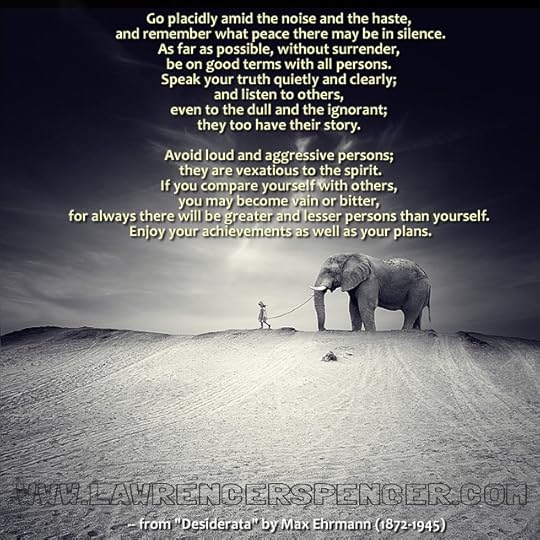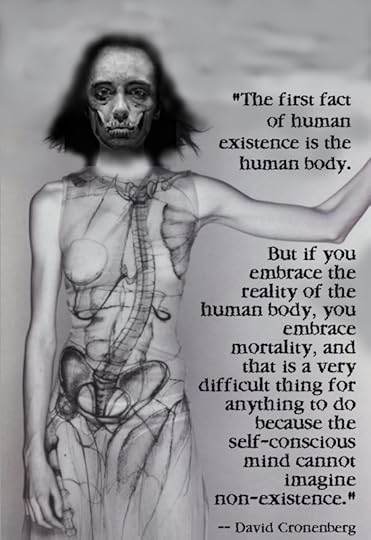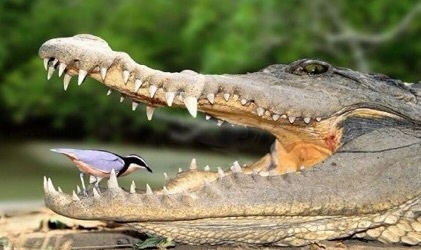Lawrence R. Spencer's Blog, page 419
January 4, 2017
PRIME MOVER UNMOVED

Unmoved moveror prime moveris a philosophical concept described by Aristotle as a primary cause or “mover” of all the motion in the universe. As is implicit in the name, the “unmoved mover” moves other things, but is not itself moved by any prior action. Aristotle describes the unmoved mover as being perfectly beautiful, indivisible, and contemplating only the perfect contemplation: itself contemplating. Unmoved movers or prime mover are, themselves, immaterial substance, (separate and individual beings), having neither parts nor magnitude. As such, it would be physically impossible for them to move material objects of any size by pushing, pulling or collision. Because matter is, for Aristotle, a substratum in which a potential to change can be actualized, any and all potentiality must be actualized in a being that is eternal but it must not be still, because continuous activity is essential for all forms of life. This immaterial form of activity must be intellectual in nature and it cannot be contingent upon sensory perception if it is to remain uniform; therefore eternal substance must think only of thinking itself and exist outside the starry sphere, where even the notion of place is undefined for Aristotle. Their influence on lesser beings is purely the result of an “aspiration or desire”, and each aetheric celestial sphere emulates one of the unmoved movers, as best it can, by uniform circular motion. — Wikipedia.org
Originally posted 2013-11-20 21:20:45. Republished by Blog Post Promoter
ENDURING ETERNITY: COMFORTABLY NUMB
As Immortal Spiritual Beings our problem is how to endure eternity: All- Knowing, All Seeing, All-Creating. How do we avoid the Eternal Pain of Knowing before the outcome of the events that we cause? This is Boredom. — the Deadliest Disease of Immorality. The end of every game is predetermined –the Affliction of The Gods. Pretend that we do NOT know? The elixir for our self-crated affliction is a lie. We know that we know. We pretend we do not. Ignorance is bliss. Pretense is the numbing drug. Lie to yourself. The pain of Eternal Boredom will desist, if you persist…. persist….. persist….. Be numb to it. Be numb. Lie to yourself. Do not know what you know…..
These are the lyrics to the song by Pink Floyd, “Comfortably Numb“:
“Hello,
Is there anybody in there?
Just nod if you can hear me
Is there anyone home?
Come on
Now
I hear you’re feeling down
I can ease your pain
Get you on your feet again
Relax
I’ll need some information first
Just the basic facts
Can you show me where it hurts?
There is no pain you are receding
A distant ship’s smoke on the horizon
You are only coming through in waves
Your lips move
But I can’t hear what you’re saying
When I was a child I had a fever
My hands felt just like
Two balloons
Now I’ve got that feeling once again
I can’t explain
You would not understand
This is not how I am
I… Have become comfortably numb
O.K.
Just a little pin prick
There’ll be no more aaaaaaaah!
But you may feel a little sick
Can you stand up?
I do believe it’s working
Good
That’ll keep you going through the show
Come on
It’s time to go
There is no pain you are receding
A distant ship’s smoke on the horizon
You are only coming through in waves
Your lips move
But I can’t hear what you’re saying
When I was a child
I caught a fleeting glimpse
Out of the corner of my eye
I turned to look but it was gone
I cannot put my finger on it now
The child is grown
The dream is gone
I… Have become comfortably numb
January 3, 2017
FRIENDS
( Image by StefanArts )
FRIENDS ARE MADE OF MUTUAL UNDERSTANDING, STRENGTH, EMPATHY and TRUST
Lawrence R. Spencer. 2013.
Originally posted 2013-11-30 01:29:47. Republished by Blog Post Promoter
DOG BREEDING BRUTALITY
 Consequences of breeding
Consequences of breeding
For almost 4,000 years people have been breeding dogs for certain traits—whether it be a physique ideal for hunting pests like badgers or a temperament suitable for companionship. But the vast number of modern breeds—and the roots of their genetically caused problems—came about over the past two centuries, as dog shows became popular and people began selectively inbreeding the animals to have specific physical features. Over time the American Kennel Club (AKC) and other such organizations have set standards defining what each variety should look like. To foster the desired appearance, breeders often turn to line breeding—a type of inbreeding that mates direct relatives, such as grandmother and grandson. When a male dog wins numerous championships, for instance, he is often bred widely—a practice known as popular sire syndrome (pdf)—and his genes, healthy or not, then are spread like wildfire throughout the breed. As a result, purebred dogs not only have increased incidences of inherited diseases but also heightened health issues due to their bodily frames and shapes, such as hip dysplasia in large breeds like the German shepherd and the Saint Bernard, and patellar luxation, or persistent dislocation of the kneecap, in toy and miniature breeds.
How did we get to this situation? “Historically, a breeder’s primary concern was to produce dogs that look like the breed standard,” explains James Serpell, professor of ethics and animal welfare and director of the Center for the Interaction of Animals and Society at the University of Pennsylvania School of Veterinary Medicine. “Even if they did recognize health problems, breeders were too driven to produce what was perceived to be the most perfect breed.”
In the 1850s, for example, the bulldog looked more like today’s pit bull terrier—sturdy, energetic and athletic with a more elongated muzzle. But by the early 20th century, when dog shows became popular, the bulldog had acquired squat, bandy legs and a large head with a flattened muzzle. This altered figure makes it nearly impossible for them to reproduce without assistance, and the facial changes cause severe breathing problems in a third of all bulldogs. Breeders frequently turn to artificial insemination because the female bulldog’s bone structure cannot support the male’s weight during mating. Most cannot give birth naturally either, because the puppies’ heads are too big for the birth canal.
Large head size and short legs are part of the written standard, so Serpell believes these standards would have forced the bulldog into extinction if breeders did not rely on artificial insemination. “By essentially requiring judges to select animals that are the written standard, the club, in a way, signed the bulldog’s death warrant,” Serpell says.
Despite the negative effects of controlled breeding, animal science experts point to the value of selecting for consistency. “A breed standard is the template providing information about the appearance and temperament and reflects the original function and purpose of the breed,” says Milan Hess, a Colorado-based veterinarian who works with the AKC. When choosing a dog as a pet, consumers look to the breed standard for certainty. “They know what it will look like and how it will act,” says Thomas Famula, an animal-breeding specialist at the University of California, Davis.
Healthy choices
With the search for consistency yielding unforeseen flaws, however, who is to blame? Although the AKC sets the breed standards, it is principally a registry organization and has little control over the actual breeding process. Famula believes dog breeders hold the highest responsibility because they make the decisions about which dogs to mate. “In the end, breeders are the ones creating the next generation of dogs,” Famula explains. But researchers like Famula and Jerold Bell, a geneticist at the Tufts University Cummings School of Veterinary Medicine, note that breeding practices are greatly influenced by the puppy buyers who Bell believes are largely ignorant about genetic issues. “The public is completely unaware. They see a cute dog and are sold,” Bell says. When purchasing a puppy, buyers can ask for medical tests and family history of diseases; but this rarely happens. “Although it’s ultimately the breeders’ responsibility, if there’s no pressure from the buyer, the system won’t change,” he adds, emphasizing that most of the top 10 diseases plaguing all dogs are controlled by single genes which, when identified, are easy to eliminate in the next generation.
Meanwhile many organizations breeding dogs for police work or to aid the disabled routinely do use data registries to maintain health information and make smart pairing decisions that reduce the prevalence of inherited ailments. The Seeing Eye, a guide dog school in Morristown, N.J., for example, uses genetic testing and keeps a database that tracks all dogs’ potential problems. “We have a geneticist on staff who evaluates each dog as a potential breeder, and we occasionally bring in dogs from other guide schools to ensure our gene pool doesn’t get too restricted,” says Michelle Barlak, senior public relations associate at The Seeing Eye.
Moving forward
It is possible to improve a breed and maintain its characteristics, of course. Consider the dalmatian. The challenge: the genes responsible for the breed’s sought-after characteristic spotting pattern also result in high levels of uric acid in the breed’s urine, predisposing them to the formation of urate crystals that frequently cause urinary blockages. Selecting against uric acid, however, would result in a spotless dalmatian. Now there’s new hope from work that began in 1973, when Robert Schaible, a geneticist at the Indiana University School of Medicine, started the Dalmatian–English Pointer Backcross Project. He paired an AKC champion dalmatian with an English pointer, a breed with normal uric acid levels and a disposition similar to that of the dalmatian, and then crossed a dog from that litter to another dalmatian and so on. In 2011, after 15 generations, the AKC allowed dalmatians from this healthier pedigree, spots intact, to register.
Looking ahead at the future of purebreds, Serpell emphasizes that the goal is not to get rid of them but rather to put the health of the animals first. “I don’t think anyone wants the breeds to disappear,” Serpell says. “I don’t want the bulldog to disappear, I just want the bulldog to be transformed back into an animal that can function properly and is reasonably healthy.”
This article is provided by Scienceline, a project of New York University’s Science, Health and Environmental Reporting Program.
January 2, 2017
THINK OUTSIDE THE BUN
January 1, 2017
PEACE WITH YOUR SELF
December 31, 2016
IMAGINE NON-EXISTENCE
“The Self-conscious mind cannot imagine non-existence.”
David Paul Cronenberg, OC, FRSC (born March 15, 1943) is a Canadian filmmaker, screenwriter and actor. He is one of the principal originators of what is commonly known as the body horror or venereal horrorgenre. This style of filmmaking explores people’s fears of bodily transformation and infection. In his films, the psychological is typically intertwined with the physical. In the first half of his career, he explored these themes mostly through horror and science fiction, although his work has since expanded beyond these genres. He has been called “the most audacious and challenging narrative director in the English-speaking world.” — Wikipedia.org
Originally posted 2012-05-10 01:16:51. Republished by Blog Post Promoter
December 30, 2016
WHO’S TOUGHER THAN A TARDIGRADE?
Imagine if these creatures were 6 feet tall….
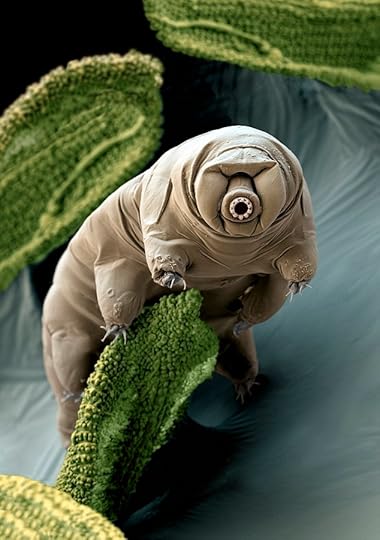
Tardigrade, kleiner Wasserbär, meaning ‘little water bear’ in German. The name Tardigrada means “slow walker” and was given by Lazzaro Spallanzani in 1777. The name water bear comes from the way they walk, reminiscent of a bear’s gait. The biggest adults may reach a body length of 1.5 millimetres (0.059 in), the smallest below 0.1 mm. Freshly hatched tardigrades may be smaller than 0.05 mm.
About 1,150 species of tardigrades have been described.Tardigrades occur throughout the world, from the Himalayas(above 6,000 metres (20,000 ft)), to the deep sea (below 4,000 metres (13,000 ft)) and from the polar regions to the equator.
The most convenient place to find tardigrades is on lichens and mosses. Other environments are dunes, beaches, soil, and marine or freshwater sediments, where they may occur quite frequently (up to 25,000 animals per liter). Tardigrades often can be found by soaking a piece of moss in spring water.
Tardigrades are able to survive in extreme environments that would kill almost any other animal. Some can survive temperatures of close to absolute zero, or 0 Kelvin (−273 °C (−459 °F)), temperatures as high as 151 °C (304 °F), 1,000 times more radiation than other animals, and almost a decade without water. Since 2007, tardigrades have also returned alive from studies in which they have been exposed to the vacuum of space for a few days in low Earth orbit. Tardigrades are the first known animal to survive in space.
Tardigrades (commonly known as waterbears or moss piglets) are small, water-dwelling, segmented animals with eight legs. It is an ancient group, with fossils dating from 530 million years ago, in the Cambrian period. They are notable for being one of the most complex of all known polyextremophiles. (An extremophile is an organism that can thrive in a physically or geochemically extreme condition that would be detrimental to most life on Earth.)
Tardigrades can withstand temperatures from just above absolute zero to well above the boiling point of water. They can survive pressures greater than any found in the deepest ocean trenches and have lived through the vacuum of outer space. They can survive solar radiation, gamma radiation, ionic radiation— at doses hundreds of times higher than would kill a person. They can go without food or water for nearly 10 years, drying out to the point where they are 3% or less water, only to rehydrate, forage, and reproduce.
Usually, Tardigrades are 1 millimetre (0.039 in) long when they are fully grown. They are short and plump with 4 pairs of legs, each with 4-8 claws also known as “disks.” The animals are prevalent in moss and lichen and, when collected, may be viewed under a very low-power microscope, making them accessible to the student or amateur scientist as well as the professional.
Originally posted 2013-02-20 00:26:15. Republished by Blog Post Promoter
HUMANS ARE NOT A SYMBIOTIC SPECIES
Obligate symbiosis is when two organisms are in a symbiotic relationship because they can’t survive without each other. Facultative symbiosis is when the species live together by choice. Human beings do not have ANY naturally occuring sybiotic relationship with ANY other life forms on Earth. This fact is proof that human beings did not “evolve” on Earth. Humans are an “alien” species. For more details, study the definitions of symbiosis here: https://en.wikipedia.org/wiki/Symbiosis
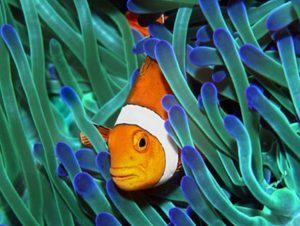 The video below demonstrates a NATURALLY OCCURRING symbiotic relationship between native species of life forms on Earth: ants and acacia trees. There are billions of such relationships between life forms that actually “evolved” on Earth, but none exist with humans. In fact, humans do not provide a mutually beneficial service to ANY creatures on Earth, with the possible exception of intestinal bacteria common to all omnivorous mammals.
The video below demonstrates a NATURALLY OCCURRING symbiotic relationship between native species of life forms on Earth: ants and acacia trees. There are billions of such relationships between life forms that actually “evolved” on Earth, but none exist with humans. In fact, humans do not provide a mutually beneficial service to ANY creatures on Earth, with the possible exception of intestinal bacteria common to all omnivorous mammals.
If the human species disappeared from Earth today no other life form would be harmed: they would flourish!
December 29, 2016
GLASS HALF REAL
~ Lawrence R. Spencer. 2014 ~
Originally posted 2014-11-10 15:12:04. Republished by Blog Post Promoter



